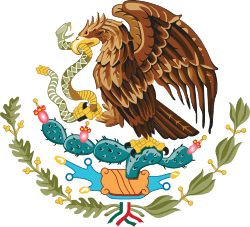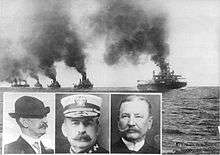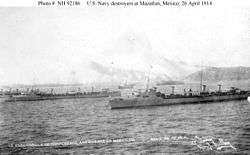Tampico Affair
| Tampico Affair | |||||||
|---|---|---|---|---|---|---|---|
| |||||||
| Belligerents | |||||||
|
|
| ||||||
| Strength | |||||||
| 9 sailors | ~10 infantry | ||||||
Part of a series on the |
|---|
| History of Mexico |
 |
|
Spanish rule |
| Timeline |
|
|
The Tampico Affair began as a minor incident involving U.S. sailors and Mexican land forces loyal to Mexican dictator[1] General Victoriano Huerta during the guerra de las facciones (faction wars) phase of the Mexican Revolution. A misunderstanding occurred on April 9, 1914, but developed into a breakdown of diplomatic relations between the two countries. As a result, the United States invaded the port city of Veracruz, occupying it for more than six months. This contributed to the fall of President Victoriano Huerta, who resigned in July 1914.
In the midst of the Mexican Revolution, de facto President Huerta struggled to defend his power and territory from the forces of Emiliano Zapata in the state of Morelos and the rapid advance of the Northern opposition Constitutionalists under the leadership of Venustiano Carranza. By March 26, 1914, Carranza's forces were 10 mi (16 km) from the prosperous coastal oil town of Tampico, Tamaulipas. There was a considerable settlement of U.S. citizens in the area due to the immense investment by U.S. firms in the local oil industry. Several U.S. Navy warships commanded by Rear Admiral Henry T. Mayo were deployed off the coast for the stated purpose of protecting American citizens and property.
The U.S. occupation of Veracruz resulted in widespread anti-American sentiment among Mexican residents, and other U.S. warships were used to evacuate U.S. nationals from both the Gulf Coast and the west coast of Mexico, taking them to refugee centers in San Diego,California; Texas; and New Orleans. As a result of anti-American sentiment, Mexico maintained neutrality during World War I, refusing to support the U.S. in Europe, all the while continuing to do business with Germany. With the U.S. threatening to invade in 1918 to take control of Tampico oil fields, Mexican President Venustiano Carranza threatened to have them destroyed to prevent their falling under U.S. control.
The affair
By the spring of 1914, diplomatic relations between the U.S. and Mexico were strained. US President Woodrow Wilson refused to recognize the presidency of Mexican General Victoriano Huerta, who had been installed as president the previous year after Huerta and the conservative rebel, General Félix Díaz, a nephew of Porfirio Díaz signed the Embassy Pact with the approval of the U.S. ambassador Henry Lane Wilson. The ambassador had since been removed by President Wilson.[2] The instability caused by the ongoing Mexican Revolution threatened American lives and economic interests in Mexico.
Although Tampico was besieged by Constitutionalist forces, relations between U.S. forces and Huerta's federal garrison remained amicable. The gunboat Dolphin, one of the few U.S. Navy vessels able to sail up the Pánuco river through the shallow harbor entrance, by request of the Mexican government had presented a 21-gun salute to the Mexican flag three times on April 2, 1914,[3] to pay tribute to the celebrated occupation of Puebla in 1867 by Mexican General Porfirio Díaz in the last phases of the war to expel the forces supporting the French intervention in Mexico.

Inset: Appearing in the photograph (left to right): Rear Admiral Henry T. Mayo, Commander of U.S. forces during the Tampico Affair; Rear Admiral Frank F. Fletcher, who commanded the landing to seize Veracruz; Vice Admiral Charles J. Badger, Commander of U.S. Atlantic Fleet in 1914.
Relations between the U.S. and Huerta deteriorated on April 9, when Mexican soldiers detained nine U.S. sailors in Tampico. The commander of the Dolphin had tasked a purser and eight sailors with the purchase and pickup of urgently needed 440 gallons[3] of gasoline fuel from a dealer located near a tense defensive position at Iturbide Bridge being held by Huerta's forces.[4] The defenders of the bridge anticipated an attack, following skirmishes with Constitutionalist forces on the two preceding days. Nine U.S. sailors on a whaleboat flying the U.S. flag were dispatched to the warehouse along a canal. According to the sailors' account, seven of them were moving the cans of fuel (either 5-gallon or 55-gallon drums?) to the boat while two remained on the boat. Mexican federal soldiers were alerted to the activity and confronted the American sailors. Neither side could speak the other's language, and the sailors were not complying with commands from the soldiers. The Mexicans raised their rifles to the Americans, including the sailors still on the boat, and forcibly escorted them to the police headquarters for questioning.
Although the sailors had been released after only a few minutes, Rear Admiral Henry T. Mayo, the commander of U.S. naval forces in the area, demanded a 21-gun salute and formal apology from Huerta's government. General Huerta, the President of Mexico, refused to have his forces raise the U.S. flag on Mexican soil to provide a 21-gun salute.
Two weeks later, negotiations were at a standstill when U.S. President Woodrow Wilson asked Congress for permission for an armed invasion of the area. Although this request was granted two days later, the U.S. occupation of Veracruz had already begun.

President Wilson backed Mayo and ordered an increase in U.S. forces in Mexican waters. On April 18, USS Iris, Lieutenant Allen B. Reed, commanding, tender for the Pacific Fleet First Torpedo Flotilla, USS Cheyenne, Lieutenant Kenneth Heron, commanding, tender for the Pacific Fleet Second Torpedo Flotilla and submarines USS H-1 and USS H-2 departed San Pedro, California for San Diego.[5] On April 22, Iris and five torpedo boats USS Whipple (DD-15), USS Paul Jones (DD-10), USS Perry (DD-11), USS Stewart (DD-13) and USS Truxton (DD-14), of the Pacific Fleet First Torpedo Flotilla, Lieutenant Commander Edwin H. Dodd, commanding, departed San Diego for Mazatlan.[6]
On April 22, President Wilson received the backing of Congress for the use of military force to resolve the conflict with Huerta. The day before, he had already ordered the Navy to seize the port of Veracruz, which was preparing to receive a German ship, the SS Ypiranga, with an important cargo of ammunition intended for Huerta's troops. This message was relayed to Rear Admiral Frank Friday Fletcher, who commanded the squadron lying off the port of Veracruz. With the battleships USS Florida (BB-30), USS Utah (BB-31) and the transport USS Prairie (AD-5) carrying 350 Marines, Fletcher received his orders at 8:00 AM on April 21. With impending poor weather conditions, Fletcher moved swiftly and requested that the American consul, William W. Canada, notify the local Mexican commander, General Gustavo Maass, that Fletcher's landing parties would be taking control of the Veracruz waterfront. After sending some two hundred soldiers to present a token defense, General Maass received orders from Mexico City to evacuate his troops to the nearby towns of Tejería and Soledad.
Mexican legislators criticized the U.S., and mobs burned the American flag and looted American businesses in Mexico City. Mexico.
Just before 11:00 AM, a US landing party of 500 Marines and 300 sailors commanded by Captain William R. Rush of USS Florida went ashore. Meeting no resistance, the Americans landed at Pier 4 and moved toward their objectives. The Navy sailors advanced to take the customs house, post and telegraph offices, and railroad terminal while the Marines were to capture the rail yard, the cable office, and the power plant. Establishing his headquarters in the Terminal Hotel, Rush sent a semaphore unit to the room to open communications with Fletcher.
While Maass retreated with his troops, the Mexican midshipmen at the Naval Academy worked to fortify their building. Fighting began when local policeman Aurelio Monffort fired on the Americans. He was killed by return fire, but his action resulted in widespread, disorganized fighting. Believing that a large Mexican force was in the city, Rush signaled for reinforcements and USS Utah sent its landing party ashore. Seeking to avoid further deaths, Fletcher asked Canada to proxy a truce with the Mexican authorities. This effort failed when no Mexican leaders could be located.
With the likelihood of further casualties from deeper incursion into Veracruz, Fletcher ordered Rush to hold his position and remain on the defensive through the night. During the night of April 21–22, additional American warships arrived bringing reinforcements. Overnight Fletcher determined that complete occupation of Veracruz was necessary. He sent additional Marines and sailors ashore to begin landing around 4:00 AM, and at 8:30 AM Rush resumed his advance, with ships in the harbor (USS San Francisco, USS Chester and USS Prairie)providing gunfire support.
Striking near the Avenida de Independencia, the Marines assaulted from structure to structure to neutralize resistance from the Huerta forces. On their left, the 2nd Seaman Regiment, led by USS New Hampshire (BB-25) Captain Edwin A. Anderson, made its way up Calle Francisco Canal.
Even though the Mexican midshipmen had evacuated their school the previous evening, some Mexican civilians had taken defensive positions inside the building.
Relying on incorrect information that his advance had been cleared of snipers, Anderson failed to send out scouts and marched his men in parade ground formation. They encountered withering fire from the Mexicans and numerous casualties, forcing them to retreat. With supporting naval gunfire, Anderson resumed the attack and seized the Naval Academy and Artillery Barracks. Additional American forces landed through the morning, and by noon the US had taken much of the city.
In the fighting, 19 Americans were killed and 72 wounded. Mexican losses were estimated at 150 to 170 soldiers killed, and between 195 and 250 wounded; an unknown number of civilians were killed.[7][8] Mexican snipers were active until April 24, when Fletcher declared martial law. On April 30, the U.S. Army's 5th Reinforced Brigade under Brigadier General Frederick Funston arrived and took over the occupation of the city. While many of the Marines remained, the naval units returned to their ships. While some in the United States called for a full invasion of Mexico, President Wilson limited American involvement to the occupation of Veracruz.
Meanwhile, on the Pacific Coast of Mexico, U.S. Naval units were monitoring the fight between Huerta's forces and the rebels while protecting U.S. citizens and interests. In Ensenada, Baja California, U.S. consul Claude E. Guyant and 250 American citizens were forced to seek safety in the American consulate building, as Mexican authorities were powerless to control anti-American demonstrations that had erupted on April 23. Guyant cabled Washington, "Have taken refuge in consulate. Situation critical. Send warship immediately."[9] USS Cheyenne was sent from San Diego, California to Ensenada with orders to protect American lives at any cost, including capturing the port if necessary. USS Iris, en route to Mazatlan, diverted course to Ensenada to assist Cheyenne. They were to evacuate Consul Guyant and other Americans.[10][11] The welfare of approximately 50,000 U.S. citizens living in Mexico was affected by the military invasion of Veracruz. Refugee camps were set up in San Diego, Texas, and New Orleans in order to receive the Americans.[12][13]
Ultimately the U.S. military transport ship USS Buford sailed from San Francisco in early May 1912, and made stops at numerous ports on the west coast of Mexico to pick up additional American refugees. USS Iris also picked up numerous American refugees during May 1914, including Clement Edwards, the U.S. Consul at Acapulco.[14]
By May 4, 1914, a total of 71 U.S. Navy ships were operating in Mexican waters.[15]
Battling rebel forces, Huerta was not able to mount a military opposition to the U.S. occupation. Following Huerta's downfall in July 1914, the U.S. began discussions with the new government of Venustiano Carranza. U.S. forces remained in Veracruz for seven months and finally departed on November 23, long after the ABC countries (Argentina, Brazil, and Chile), having organized the Niagara Falls peace conference, held in the British Dominion of Canada, had failed to settle many of the issues between the two countries.
Legacy
The U.S. occupation of Veracruz contributed to Huerta's resignation in August of that year, as his southern armies' supplies ran out. In addition, the Tampico incident had later repercussions, as there were lingering U.S.-Mexican resentments. In January 1917 Germany sent the so-called Zimmermann Telegram, which implied that a Mexican alliance with Germany against the U.S. would result in Mexico regaining territory taken from it by the U.S. in prior wars, and that Germany's forthcoming unrestricted submarine warfare campaign would guarantee defeat of the British and French. British interception of Zimmermann's telegram, and German unrestricted submarine warfare against U.S. merchant ships soon after, were effectively the final justifications President Wilson needed to request a declaration of war against Germany in April 1917.[16] The anti-American feelings in Mexico resulting from the Tampico incident were chiefly the reason that the government kept Mexico neutral in World War I.[17] Mexico refused to participate with the U.S. military excursion in Europe and granted full guaranties to German companies for keeping their operations open, specifically in Mexico City.[18]
U.S. President Woodrow Wilson considered another military invasion of Veracruz and Tampico in 1917–1918,[19][20] so as to take control of the Tehuantepec Isthmus and Tampico oil fields.[20][21] The relatively new Mexican President Venustiano Carranza threatened to destroy the oil fields in case the Marines landed there.[22][23]
See also
References
- ↑ http://www.jornada.unam.mx/2015/01/02/estados/024n1est
- ↑ "Wilsonian Missionary Diplomacy- Intervention in Mexico". Retrieved 27 November 2014.
- 1 2 Logbook of USS Dolphin
- ↑ Lenz, Lawrence (2008). Power and Policy: America's First Steps to Superpower 1889-1922. New York: Algora Publishing. p. 186. ISBN 0875866638.
- ↑ "The Washington Times, April 18, 1914". Retrieved 27 November 2014.
- ↑ "More Battleships Ordered to Mexico". The New York Sun. 23 April 1914. Retrieved 27 November 2014.
- ↑ Alan McPherson (2013) Encyclopedia of U.S. Military Interventions in Latin America, p. 393, ABC-CLIO, U.S.
- ↑ Susan Vollmer (2007) Legends, Leaders, Legacies, p. 79, Biography & Autobiography, U.S.
- ↑ Shepherd, William G. (24 April 1914). "Blind with Anger Huerta Allowed Mobs to Riot in Mexico". The Day Book. Chicago. Image 4. Retrieved 27 November 2014.
- ↑ "New Appeal from Ensenada". The New York Sun. 25 April 1914. Retrieved 27 November 2014.
- ↑ "Army and Navy Orders". The Washington Times. 24 April 1914. Retrieved 27 November 2014.
- ↑ John Whiteclay Chambers & Fred Anderson (1999) The Oxford Companion to American Military History, p. 432, Oxford University Press, England.
- ↑ Michael Small (2009) The Forgotten Peace: Mediation at Niagara Falls, 1914, p. 35, University of Ottawa, Canada.
- ↑ "Rescue Party Off for West Coast Monday". The Bisbee Daily Review (Arizona). 28 April 1914. Retrieved 27 November 2014.
- ↑ "71 US Warships Operating in Mexico". El Paso Herald. 4 May 1914. Retrieved 27 November 2014.
- ↑ Andrew, Christopher (1996). For The President's Eyes Only. Harper Collins. ISBN 0-00-638071-9.
- ↑ Lee Stacy (2002) Mexico and the United States, Volume 3, p. 869, Marshall Cavendish, U.S.
- ↑ Jürgen Buchenau (2004) Tools of Progress: A German Merchant Family in Mexico City, 1865-present, p. 82, UNM Press, U.S.
- ↑ Ernest Gruening (1968) Mexico and Its Heritage, p. 596, Greenwood Press, U.S.
- 1 2 Drew Philip Halevy (2000) Threats of Intervention: U. S.-Mexican Relations, 1917-1923, p. 41, iUniverse, U.S.
- ↑ Lorenzo Meyer (1977) Mexico and the United States in the oil controversy, 1917-1942, p. 45, University of Texas Press, U.S.
- ↑ Stephen Haber, Noel Maurer, Armando Razo (2003) The Politics of Property Rights: Political Instability, Credible Commitments, and Economic Growth in Mexico, 1876-1929, p. 201, Cambridge University Press, UK.
- ↑ Lorenzo Meyer (1977) Mexico and the United States in the Oil Controversy, 1917–1942, p. 44, University of Texas Press, U.S.
External links
- Wilson "exasperated by... the latest in a line of Mexican incidents"
- Wilson's address to Congress (20 April 1914)